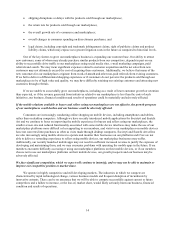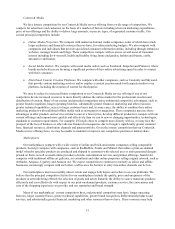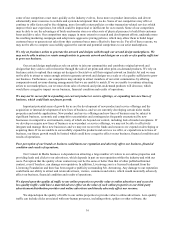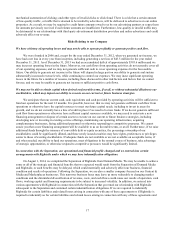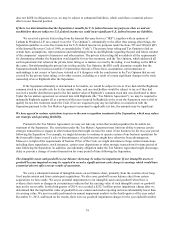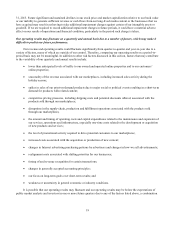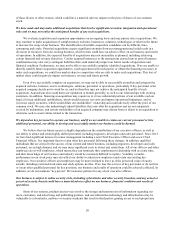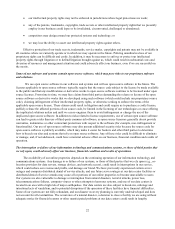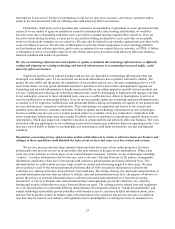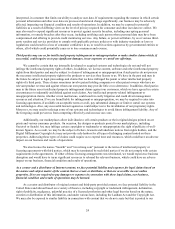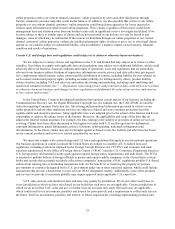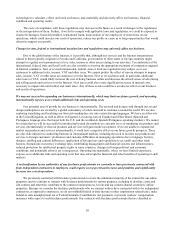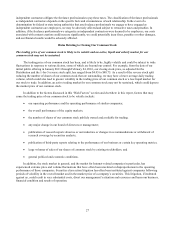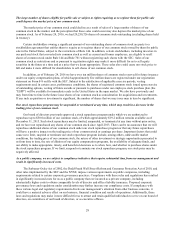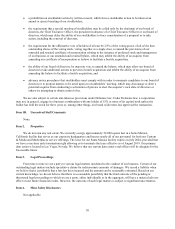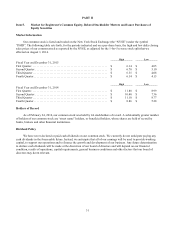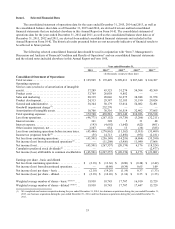Enom 2015 Annual Report Download - page 25
Download and view the complete annual report
Please find page 25 of the 2015 Enom annual report below. You can navigate through the pages in the report by either clicking on the pages listed below, or by using the keyword search tool below to find specific information within the annual report.23
interruptions in our service. Delays or interruptions in our service may cause our users, advertisers, customers and/or
artists to become dissatisfied with our offerings and could adversely affect our business.
Furthermore, third-party service providers may experience an interruption in operations or cease operations for any
reason. If we are unable to agree on satisfactory terms for continued data center hosting relationships, we would be
forced to enter into a relationship with other service providers or assume hosting responsibilities ourselves. If we are
forced to switch hosting facilities, we may not be successful in finding an alternative service provider on acceptable
terms or in hosting the computer servers ourselves. We may also be limited in our remedies against these providers in the
event of a failure of service. We also rely on third-parties to provide certain components of our technology platform,
such as hardware and software providers, and to serve as operators for our content delivery networks, or CDNs. A failure
or limitation of service or available capacity by any of these third-party providers could adversely affect our business,
financial condition and results of operations.
We rely on technology infrastructure and a failure to update or maintain this technology infrastructure, or difficulty
scaling and adapting our existing technology and network infrastructure to accommodate increased traffic, could
adversely affect our business.
Significant portions of our content, products and services are dependent on technology infrastructure that was
developed over multiple years. To be successful, our network infrastructure has to perform well and be reliable. The
greater the user traffic and the greater the complexity of our products and services, the more computing power we will
need. In the future, we may spend substantial amounts to purchase or lease data centers and equipment, upgrade our
technology and network infrastructure to handle increased traffic on our online properties and roll out new products and
services. Updating and replacing our technology infrastructure could be challenging to implement and manage, take time
to test and deploy, cause us to incur substantial costs, cause us to suffer data loss, delays or interruptions in service or
result in inefficiencies or operational failures. If we do not successfully update our technology and network infrastructure
as needed, or if we experience inefficiencies and operational failures during such updates, the quality of our products and
services and our users’ experience could decline. This could damage our reputation and lead us to lose current and
potential users, advertisers, customers and artists. Failure to update our technology infrastructure as new technologies
become available may also put us in a weaker position relative to a number of our key competitors. Competitors with
newer technology infrastructure may have greater flexibility and be in a position to respond more quickly than us to new
opportunities, which may impact our competitive position in certain markets and adversely affect our business. The costs
associated with any adjustments to our technology and network infrastructure could also harm our operating results. Cost
increases, loss of traffic or failure to accommodate new technologies could harm our business, revenue and financial
condition.
Regulations concerning privacy and protection of data could subject us to claims or otherwise harm our business and
changes in these regulations could diminish the value of our services and cause us to lose visitors and revenue.
We receive, process and store large amounts of personal data from users of our online properties, freelance
professionals who provide services to us and artists who post artworks or designs on our marketplaces. When a user
visits one of our websites or certain pages of our content channel customers’ websites, we use technologies, including
“cookies,” to collect information related to the user, such as the user’s Internet Protocol, or IP, address, demographic
information, and history of the user’s interactions with content or advertisements previously delivered by us. The
information that we collect about our users helps us deliver content and advertising targeted to these users. We post
privacy policies on all of our owned and operated websites that set forth our policies and practices related to the
collection, use, sharing, disclosure and protection of personal data. The storing, sharing, use, disclosure and protection of
personal information and user data are subject to federal, state and international privacy laws, the purpose of which is to
protect the privacy of personal information that is collected, processed and transmitted in or from the governing
jurisdiction. A variety of federal, state and international laws and regulations govern the collection, use, retention,
sharing and security of data that we receive from and about our users. The existing privacy-related laws and regulations
are evolving and subject to potentially differing interpretations. Developments related to “instant personalization” and
similar technologies potentially provide publishers with broader access to, and more detailed information about, users
and have led to greater scrutiny of industry data collection practices by regulators and privacy advocates. In addition,
new laws may be enacted, new industry self-regulation may be promulgated, or existing laws may be amended or re-



